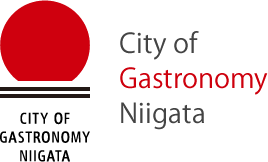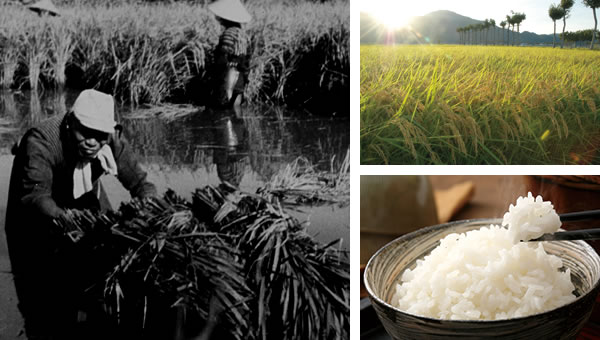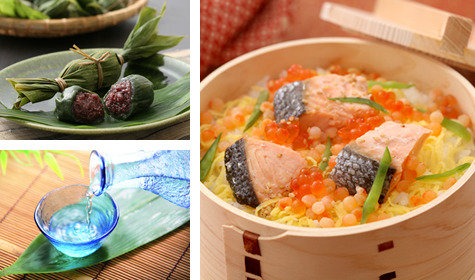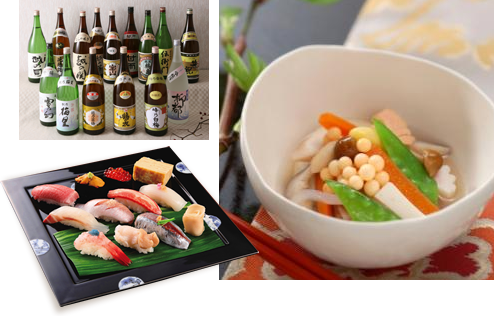
In August 2014, the Niigata Creative City of Gastronomy Promotion Board was established through collaboration with industry, academia, public and private sectors, aiming at increasing visitors and revitalizing local industries by further sophisticating the gastronomic culture of the City of Niigata and widely transmitting information within the city and to the world. The Board provides assistance to its members for their activities to further develop gastronomic culture, while targeting at the establishment of a gastronomic network among the City of Niigata and cities in the world, as well as people living there.
Niigata’s gastronomy
Introduction
Niigata’s gastronomy is composed of rice-based cuisine that uses a diverse variety of ingredients.
As a region, Niigata is one of Japan’s foremost producers and manufacturers of rice. This is thanks to the rich local environment - an environment defined by both a plentiful physical landscape, as well as a rich cultural landscape shaped by the unbending determination and august efforts of the region’s people. For Niigata was once a vast, unexploited low-lying wetland until, after many years of persistent labor, the people of Niigata succeeded in transforming it into Japan’s most productive rice belt.
As a port town, Niigata has welcomed diverse cultures, integrating new influences and developing its unique gastronomy. Today, Niigata actively organizes and participates in various food-related events and programs, widely disseminating information on its food culture within and without Japan.
Upon becoming a member of the UNESCO’s Creative Cities Network as a City of Gastronomy, Niigata intends to engage in a broader range of activities to serve the world through gastronomy.
Introduction
Niigata’s gastronomy is composed of rice-based cuisine that uses a diverse variety of ingredients.
As a region, Niigata is one of Japan’s foremost producers and manufacturers of rice. This is thanks to the rich local environment - an environment defined by both a plentiful physical landscape, as well as a rich cultural landscape shaped by the unbending determination and august efforts of the region’s people. For Niigata was once a vast, unexploited low-lying wetland until, after many years of persistent labor, the people of Niigata succeeded in transforming it into Japan’s most productive rice belt.
As a port town, Niigata has welcomed diverse cultures, integrating new influences and developing its unique gastronomy. Today, Niigata actively organizes and participates in various food-related events and programs, widely disseminating information on its food culture within and without Japan.
Upon becoming a member of the UNESCO’s Creative Cities Network as a City of Gastronomy, Niigata intends to engage in a broader range of activities to serve the world through gastronomy.
Niigata: a City of Gastronomy
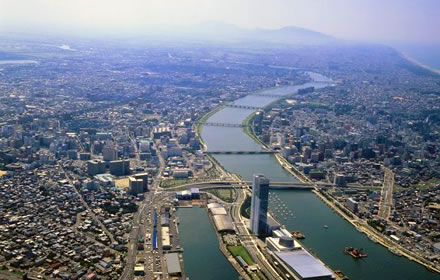
Niigata: a City of Gastronomy
Rice is the principal staple of Asia. Koshihikari, a Japanese variety of rice, is considered one of the best in the world. And of Japan’s Koshihikari producers, Niigata is the top in terms of both quality and quantity.
Niigata’s gastronomy has been influenced by the rich natural environment and the region’s historical background. The City of Niigata is situated on a vast plain at the mouth of two great rivers facing the Sea of Japan. The rivers run through the city, and the mountain ranges that constitute the backbone of Honshu (the Japanese mainland) lie behind the city. These varied topographical traits have blessed Niigata with abundant rice as well as other agricultural, marine, and livestock products.
Niigata enjoys four distinct seasons: spring, when flowering plants start to bud and the snows begin to melt; summer, when life flourishes and the land is dyed deep green; autumn, with vibrant red and gold foliage; and winter, when life slumbers and the region is blanketed in pure white snow.
The change that accompanies these seasonal transformations contributes to Niigata’s diverse natural blessings.
Historically, Niigata has flourished as a port town since the 17th century. As the Niigata Plain represented the largest rice producing region in Japan, the City of Niigata was an important base for the transportation of rice to Edo (modern-day Tokyo) and Osaka. Trade brought different cultures from other regions to Niigata, stimulating its creativity and encouraging the development of a sophisticated culture of hospitality best represented by Niigata’s traditional restaurants, the Ryotei.
The Shinano and Agano Rivers are the heart of Niigata’s rich abundance. But in the past these two great rivers often swelled and flooded, and Niigata was a vast wetland. Niigata’s farmers were forced to work in waist-deep water to grow their rice. But with creativity and incredible tenacity, the farmers 2 of Niigata developed the kind of world class drainage techniques necessary to convert Niigata’s muddy fields into Japan’s most productive rice paddies. They also tirelessly worked to create superior strains of rice. In this way, Niigata succeeded in becoming Japan’s number one rice producer both in quality and quantity. Over the years, Niigata’s agricultural expertise has been transmitted to other countries, contributing to food production worldwide.
Approaches Taken by the Promotion Board
The Niigata Creative City of Gastronomy Promotion Board is taking a comprehensive approach toward the goal of establishing a gastronomic network.
Cities of Gastronomy Meeting
※click to enlarge
| 【Date】 |
May 25, 2015 |
| 【Venue】 |
Hotel Kanazawa (Kanazawa City) |
| 【Participating cities】 |
Chengdu (China), Ostersund (Sweden), Jeonju (Korea), Zahle (Lebanon), Florianopolis (Brazil), Shunde (China), Tsuruoka City, Niigata City, Kanazawa City
|
【Content】
Taking the opportunity of 2015 Annual Meeting of the UNESCO Creative Cities Network Kanazawa, Cities of Gastronomy were invited to this meeting to share approaches of each city and discuss possible collaborations among Cities of Gastronomy in the future. Sake and local dishes from Tsuruoka City, Niigata City, and Kanazawa City were introduced.
2015 Kick-off Meeting
※click to enlarge
| 【Date】 |
May 18, 2015 |
| 【Venue】 |
Bandai Silver Hotel (Niigata City) |
| 【Participating cities】 |
- Kick-off meeting: 93 persons from 58 companies and organizations
- Reception: 59 persons from 36 companies and organizations |
【Content】
Prior to the start of the Promotion Board’s activities in 2015, a kick-off meeting was held to discuss Niigata City’s re-application to the UCCN (Gastronomy field), report the activities conducted by the Promotion Board, and share information at seminars.
Niigata-Tsuruoka Gastronomic Journey
※click to enlarge
| 【Date】 |
February 15, 2015 |
| 【Participants】 |
70 persons (52 citizens invited/participated from Japan, 18 guests (including 6 translators) invited from abroad) |
【Content】
Through collaboration between Niigata City and Tsuruoka City of Yamagata Prefecture, both having rich nature and gastronomic cultures, a train trip was arranged for JR Uetsu Honsen Line (between Niigata Station and Tsuruoka Station) using a special domeliner to enjoy scenic views. With famous chefs from both cities giving instructions and supervisions for cooking, dishes were prepared using locally-grown ingredients and local recipes, and participants enjoyed these dishes on the train.
Creative City of Gastronomy Niigata Symposium
※click to enlarge
| 【Date】 |
February 14, 2015 |
| 【Venue】 |
Hotel Italia-ken (Niigata City) |
| 【Participating cities】 |
Qingdao (China), Cheongju (Korea), Chengdu (China), Jeonju (Korea), Popayan (Colombia), Tsuruoka City, Niigata City |
| 【Number of participants】 |
188 persons |
【Content】
Upon being designated as a Culture City of East Asia 2015, Niigata City hosted a symposium to further deepen understanding and exchanges of food cultures of China, Korea, and Japan. The program included 1) a keynote speech, 2) a panel discussion by the representatives invited from Japan and overseas, and 3) a dinner party where local and international dishes were served.
Niigata-Tsuruoka Gastronomic Collaboration Bento (Boxed Lunch)
※click to enlarge
| 【Date】 |
December 11, 2014 to January 19, 2015 |
| 【Sold at】 |
Tokyo Station, Shinagawa Station, Shinjuku Station, Ueno Station, Omiya Station |
| 【Number portions prepared】 |
10,000 meals |
【Content】
Niigata City and Tsuruoka City of Yamagata Prefecture both applied for the designation as a UCCN Creative City of Gastronomy at the same time, together invented recipes for bento lunch boxes and sold them at major stations to appeal the rich nature and traditional gastronomic cultures of two cities. Famous chefs from two cities gave advice and instructions for cooking. Introduction of dishes, chefs and two cities appeared on the package of bento boxes.
Visit to Niigata City by the delegation from Hondarribia, Spain
※click to enlarge
| 【Date】 |
December 3 and December 4, 2014 |
【Content】
Hondarribia is a port city located in Basque county, Spain, with many tourist attractions. Niigata had a chance to greet the Hondarribia delegation at the 12th Popayan Gastronomic Conference held in September 2014. Two representatives visited Niigata for exchange of opinions about UCCN and inspection of agro-food facilities within the city.
Attendance at the 12th Gastronomic Conference at Popayan
(XII Congreso Gastronómico de Popayán)
※click to enlarge
| 【Date】 |
September 18 to 21, 2014 |
| 【Held at】 |
Popayan, Colombia |
| 【Organized by】 |
Popayan Gastronomic Foundation (Corporación Gastronómica de Popayán) |
【Content】
Popayan is the first city designated as a UCCN City of Gastronomy. This conference introduced Popayan’s gastronomic culture, while offering workshops and tasting opportunities, etc. Representatives were invited from different cities of different countries for them to attend a presentation session about local dishes and to have dinners with chefs.
City of Niigata attended as an observer city to learn Popayan’s and other UCCN Gastronomic Cities’ pioneering approaches and to introduce Niigata’s food culture to the participating cities.
©Niigata Creative City of Gastronomy Promotion Board








